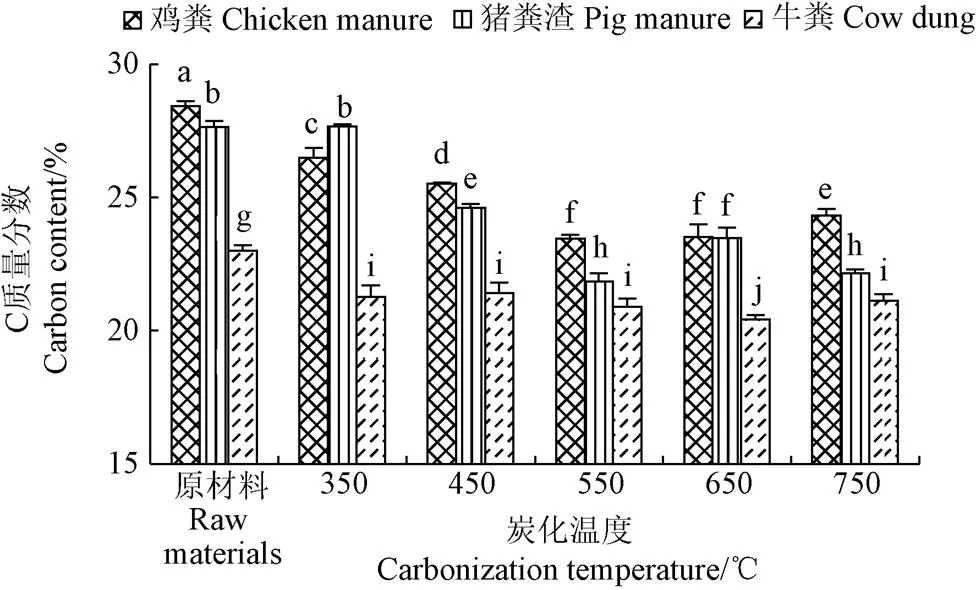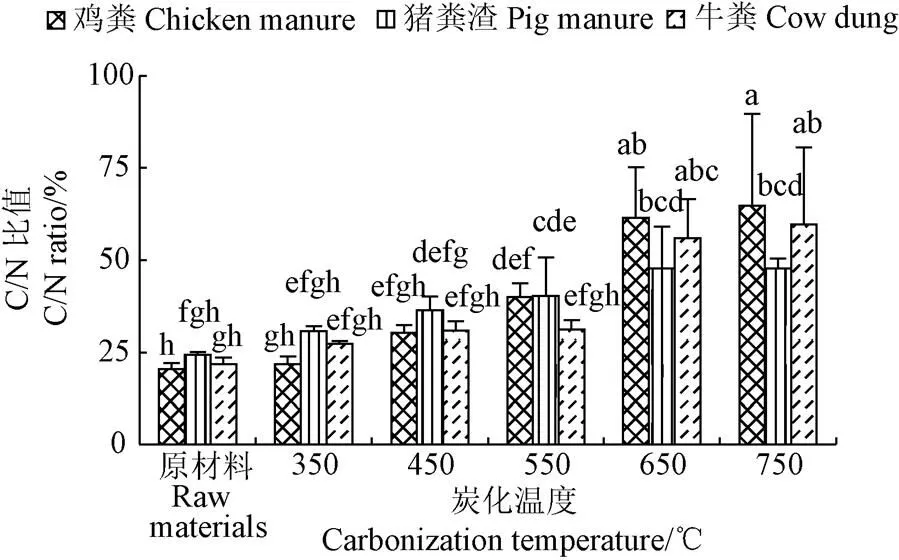不同热解温度限氧制备的畜禽粪便生物炭养分特征
王煌平,张 青,章赞德,罗 涛,翁伯琦,钟少杰
不同热解温度限氧制备的畜禽粪便生物炭养分特征
王煌平1,2,张青1,2,章赞德3,罗涛4※,翁伯琦4,钟少杰1,2
(1. 福建省农业科学院土壤肥料研究所,福州,350013;2. 福建省地力培育工程技术研究中心,福州,350013;3. 福建省大田县农田建设与土肥技术推广站,大田,366100;4. 福建省农业科学院农业生态研究所,福州 350013)
为了分析畜禽粪便生物炭中的养分特征变化,以鸡粪、猪粪渣和牛粪为原料,采用限氧控温法制备生物炭,研究了不同热解温度(350、450、550、650和750 ℃)的畜禽粪便生物炭灰分含量,C含量、大量和中微量元素养分含量及其残留率的变化,并分析了C/N比值,原材料与炭化产品养分含量、及热解温度和生物炭养分特征的相关性。结果表明,随着热解温度的升高,畜禽粪便生物炭C、N含量逐渐下降,灰分含量和P、K、Ca、Mg、Fe、Mn养分含量逐渐增加。高温热解虽增加畜禽粪便生物炭的养分总量和C/N比值,但也降低了各养分残留率。综合分析表明,畜禽粪便生物炭养分含量及其残留率与原材料中的养分含量、热解温度密切相关,其中与热解温度相关性显著。因此,选择高C和高养分含量的畜禽粪便原材料是提升生物炭养分含量的基础,而适宜温度是保留生物炭较高养分残留率的关键。该研究中畜禽粪便适宜热解温度为450 ℃,该温度下各生物炭的养分残留率整体表现为牛粪>猪粪渣>鸡粪。
热解;温度;养分;限氧;畜禽粪便;生物炭
0 引 言
中国是世界上最大的畜禽养殖国,随着畜禽养殖业规模化发展,畜禽粪便总量持续增加且更趋集中。据农业部数据,当前中国每年畜禽粪污产生量约3.8×109t,但由于长期以来的种养分离,使得畜禽粪污综合利用率不足60%,养殖产业的环境问题愈发凸显[1]。近年来,随着畜禽粪便资源化利用模式研究的发展,畜禽粪便生物炭的制备和应用也日益受到关注[2]。与当前主流的堆肥化处理相比,生物炭制备可快速实现畜禽粪便的减量化、无害化和资源化利用,减少粪便堆积等带来的环境问题,而且产生的生物炭具有较高的经济效益[3-4]。
与秸秆和木质生物炭相比,畜禽粪便生物炭含有较高的pH值和矿质养分,可有效改良酸性土壤并补充养分给贫瘠土壤[5]。Spokas等[6]研究认为,部分生物炭施用导致作物减产的主要原因是由于其矿质养分含量低,使单位体积土壤直接供给作物根系的养分减少。而畜禽粪便生物炭制备可钝化自身重金属的有效性,其施用还可增加土壤中矿质养分含量,不同程度上提升土壤养分的生物有效性[7-9]。Meta分析表明,家禽粪便制备的生物炭可使作物增产28%,增产潜力最为显著[10]。因此,选择适宜的炭化方法以提升生物炭碳和矿质养分保留量是畜禽粪便生物炭制备和应用的关键。
生物炭可由热解炭化或水热炭化2种方法制得,其中限氧下热解炭化是当前工业生物炭生产的主流方向[7,11]。与水热炭化技术相比,热解炭化制备的秸秆和木质生物炭pH值、C含量、养分含量均较高[12]。Duman等[13]认为,热解炭化制备的葡萄渣生物炭稳定性、C含量高于水热炭,且生物炭的水溶性含氮化合物主要以硝态氮和铵态氮的形式存在。模型分析表明,热解炭化制备的芒草生物炭在土壤中的降解半衰期为水热炭的20多倍[14]。Gascó[15]等研究表明,热解炭化制备的畜禽粪便生物炭具有更多的芳香族结构和更高的热稳定性。可见,水热炭化和热解炭化技术虽各有利弊,但热解生物炭的pH值、养分含量和稳定性等方面优于水热炭。在热解炭化条件的探索中,热解温度、加热速率、停留时间等对生物炭理化性质均有影响,其中以热解温度的影响最大[16-17]。
鉴于此,本文以大中型养殖场鸡粪、固液分离后的猪粪渣和牛粪制备的生物炭为研究对象,在前期研究的基础上,进一步研究限氧热解进程中温度对畜禽粪便灰分、C含量、大量和中微量元素养分含量及其残留率的变化,并分析原料来源与生物炭养分含量、及热解温度和生物炭养分特征的相关性,以期为资源化利用畜禽粪便提供数据补充和技术支撑。
1 材料与方法
1.1 原材料及生物炭的制备
供试的鸡粪、猪粪渣和牛粪均采自福建省福州市近郊养殖场,原材料自然风干粉碎,过10目筛置于干燥器。采用限氧控温炭化法[18],先将原材料在烘箱中80 ℃烘干至含水率<0.5%,然后将烘干的鸡粪、猪粪渣和牛粪(分别标记为CM、PR、DM),分别塞满本课题组自行设计的具筛石英瓶中[3],该设计可使外面空气不易进入石英瓶内,且畜禽粪便热解过程中产生的气体能够排出,使得石英瓶处于限氧状态。旋紧磨砂外盖密封,称质量后在马弗炉内升温至不同温度(350、450、550、650和750 ℃),维持1 h,马弗炉自然冷却至室温,石英瓶内残留的固态物质即为畜禽粪便生物炭。每个样品重复3次,马弗炉内随机排列,制备好的生物炭装于自封袋中并作好标记置于干燥器内。
1.2 生物炭灰分与养分特征分析
1.2.1 灰分和C含量测定
灰分含量测定参照农业行业标准NY/T 1881.5-2010[19],C含量采用碳氮元素分析仪(Vario EL III,德国Elementar公司)测定。
1.2.2 大量元素NPK含量测定
N、P、K全量分析分别采用凯氏定氮法、钒钼黄吸收光度法和火焰光度法[20-21]。
1.2.3 中量元素Ca、Mg和微量元素Fe、Mn含量测定
Ca、Mg全量用干灰化-稀盐酸溶解法制备待测液[21]。Fe、Mn全量待测液制备步骤为:称取约0.3000 g烘干的畜禽粪便原材料或0.1000 g的生物炭于30 mL 聚四氟乙烯消解管,先后加入6 mL HNO3(体积分数65%)和3 mL HF(体积分数40%),摇匀密封后置于微波消解仪(BHW-09C,上海博通化学科技有限公司),160 ℃消解5 min,升温速度20 ℃/min。用于分析中微量元素的消煮液均用超纯水定容至50 mL,再取样稀释成适宜的倍数,用火焰原子吸收分光光度计(SP3801 AAS,上海光谱仪器有限公司)测定。同时以土壤标准物质(GBW07405,北京艾科盈创生物技术有限公司)作样品分析的参照样品。所用试剂均为优级纯。依据公式(1)计算中微量元素含量。

式中为中微量元素含量,g/kg;为仪器测定的待测液中微量元素(Ca,Mg,Fe,Mn)浓度,mg/L;为测试液体积,本文取值为50 mL;s为分取倍数;为称取样品质量,g。
1.2.4 养分残留率
养分残留率(nutrient remaining rate,NR)可用于确定各元素在生物炭热解制备过程中的残留程度,以表征各养分在生物炭中的挥发损失情况。NR<100%则表示生物炭中该元素的挥发损失大于整个畜禽粪便样品中的挥发量,而NR≈100%表明该养分保留在生物炭中。依据公式(2)计算养分残留率。

式中biochar为不同热解温度下畜禽粪便生物炭各元素含量,g/kg;manure为畜禽粪便原材料各元素含量,g/kg;biochar为生物炭质量,g;manure为原材料质量,g。
1.3 数据分析
试验结果为3次重复的平均值,采用Microsoft Excel 2007对试验数据进行整理和作图。通过DPS 16.05软件分析文中各指标的差异性和相关性,多重比较采用Least Significant Difference(LSD)法进行差异显著性检验,显著性水平为<0.05。
2 结果与分析
2.1 热解温度对畜禽粪便生物炭灰分含量变化的影响
生物炭的灰分主要由P、K、Ca、Mg、Fe的氧化物或盐类的形式存在[22-23]。由图1可看出,畜禽粪便生物炭工业分析中的灰分含量随着热解温度的升高而呈递增的趋势,当温度从350 ℃升高至750 ℃,鸡粪(CM)、猪粪渣(PR)和牛粪(DM)生物炭灰分含量分别显著增加了49.25%、57.65%和43.28%(<0.05)。相同温度下畜禽粪便生物炭灰分含量大小均依次表现为CM>PR>DM,其中450~750 ℃三者间的灰分含量差异达显著水平(<0.05)。350 ℃升温到750 ℃,畜禽粪便生物炭挥发分含量显著降低了35.34%~50.69%(<0.05),而固定碳含量差异不明显[3]。因此,生物炭灰分含量的增大,可能是因为生物质热解炭化过程中有机质和可挥发性物质逐渐减少,氧化物及硅酸盐等不可挥发性物质大量残存于生物炭中,造成灰分相对含量上升[24]。

注:柱上不同小写字母表示5%水平显著差异,下同。
2.2 热解温度对畜禽粪便生物炭C含量变化的影响
图2显示,随着热解温度的升高,CM、PR、DM生物炭的C含量整体呈递减趋势,三者C含量分别从原材料的28.43%、27.65%和23.02%,显著降低到750 ℃的24.33%、22.16%和21.12%(<0.05),降幅分别为14.42%、19.86%和8.25%,以PR生物炭C含量降幅为最大。相同温度下,350 ℃的畜禽粪便生物炭C含量大小表现为PR>CM>DM,其余温度段均依次表现为CM>PR>DM。与秸秆生物炭C含量随温度升高而增加的趋势相反[25],本研究畜禽粪便生物炭C含量总体表现为随温度升高而降低,这与Cantrell等[26]在畜禽粪便源生物炭制备上的研究结果相似。

图2 不同热解温度下的畜禽粪便生物炭C含量变化
2.3 热解温度对畜禽粪便生物炭大量和中微量元素养分含量变化的影响
表1表明,随着热解温度的升高,生物炭N含量逐渐降低,P、K、Ca、Mg、Fe、Mn含量逐渐增加,且养分总量也呈递增的趋势。从原材料升温至750 ℃,CM、PR和DM的大量元素N含量分别降低了70.71%、59.62%、64.18%,而P和K含量分别增加了128.54%、85.84%、88.91%和85.03%、123.26%、89.51%;中量元素Ca和Mg含量分别增加了140.84%、169.03%、68.66%和110.97%、123.30%、33.02%;微量元素Fe和Mn含量分别增加了76.16%、103.62%、63.92%和56.92%、66.67%、75.19%,各养分含量的差异均达显著水平(<0.05)。对畜禽粪便大量和中微量养分总量分析表明,与原材料总养分相比,750 ℃下的CM、PR和DM养分总量显著增加了100.85%、79.62%和64.02%(<0.05)。相同温度下畜禽粪便生物炭中,大量元素N含量高低分别依次为CM>PR≈DM,P含量表现为DM>PR>CM,K含量为CM>PR>DM;中量元素Ca含量高低为CM>PR≈DM,Mg含量350~550 ℃为CM>PR≈DM,650~750 ℃为PR>CM>DM;微量元素Fe含量高低为DM>PR>CM,Mn含量为DM>CM≈PR。本研究畜禽粪便生物炭养分含量的变化趋势与多数研究结果一致[26-27]。
2.4 热解温度对畜禽粪便生物炭养分残留率变化的影响
表2对养分残留率的分析表明,温度越高,畜禽粪便生物炭C和各养分残留率均显著降低(<0.05)。当温度从350 ℃增加到750 ℃,CM、PR和DM处理的C残留率分别降低了58.25%、78.40%、76.07%,大量元素N、P、K残留率分别降低了85.01%、86.13%、88.23%,33.31%、69.54%、68.78%和40.27%、54.83%、71.29%;中量元素Ca和Mg残留率降低了45.18%、64.44%、71.21%和47.22%、56.94%、73.52%;微量元素Fe和Mn残留率降低了40.84%、64.32%、70.91%和39.19%、68.11%、67.64%。从表2还可看出,当温度从450 ℃升高到550 ℃,C和各养分损失量最大,差异也均达显著水平(<0.05)。相同温度下畜禽粪便生物炭中,350~450 ℃温度段,C残留率表现为DM≈PR>CM;N残留率350 ℃为CM≈PR≈DM(CM>DM),450 ℃为DM>PR≈CM;P残留率350 ℃为PR>DM≈CM,450 ℃为DM>PR≈CM;K残留率为DM>CM≈PR;Ca残留率为PR>CM>DM;Mg残留率为CM>PR>DM;Fe残留率为PR≈DM>CM;Mn残留率350 ℃为PR≈DM>CM,450 ℃为DM>PR>CM。550~750 ℃温度段,除N残留率差异不明显外,C和其他养分残留率均表现为CM>PR>DM。

表1 不同热解温度下的畜禽粪便生物炭养分含量变化
注:表中同一养分含量的不同小写字母表示5%水平显著差异,下同。
Note: Different small letters in the same nutrient content above the table mean significant difference at 5% level, the same below.

表2 不同热解温度下的畜禽粪便生物炭养分残留率变化
2.5 热解温度对畜禽粪便生物炭C/N的影响
生物炭施用可提高土壤C/N比值[23]。由图3可知,畜禽粪便原材料的C/N比值均小于25∶1,随着热解温度的升高,CM、PR、DM生物炭C/N比值呈递增的趋势。从原材料升温至750 ℃,CM、PR和DM生物炭的C/N比值分别显著提高了217.73%、97.32%、173.76%(<0.05)。相同温度下畜禽粪便及其生物炭的C/N比值差异均不明显。研究表明,低矿质养分,高C/N比值的木质和秸秆生物炭反而降低土壤N素利用率[28],而对于高矿质养分的畜禽粪便生物炭C/N比值变化对土壤养分吸收的影响目前尚不清楚。

图3 不同热解温度下的畜禽粪便生物炭C/N变化
2.6 原材料和热解温度与生物炭养分特征的相关性
对同一原材料及其炭化养分特征的相关分析表明,除N和Mg外,畜禽粪便生物炭C含量和其他养分含量均与原材料相应的养分含量呈正相关(表3)。其中C含量在350、650 ℃显著相关(<0.05),450 ℃极显著相关(<0.01),而所有温度段的P、K、Ca、Fe、Mn含量间的相关性均达显著或极显著水平(<0.05)。N含量在350 ℃极显著正相关(<0.01),随着温度的升高,相关性逐渐变弱,从450 ℃显著正相关(<0.05)发展到550 和650 ℃的负相关。Mg含量在所有温度段均为负相关,其中450、550 ℃相关性分别达显著(<0.05)和极显著水平(<0.01)。

表3 同一原材料及其炭化产品养分含量的相关性
注:*代表显著相关<0.05,**代表极显著相关<0.01,下同。
Note: * means significant difference at 5% level, ** means extremely significant difference at 1% level, the same below.
热解温度和生物炭灰分和养分特征变化的相关性分析表明,热解温度与CM、PR 和DM生物炭的灰分、养分总量、P、K、Ca、Mg、Fe、Mn含量呈显著(<0.05)或极显著(<0.01)正相关,与N含量呈极显著(<0.01)负相关,与C含量相关性不强(表4)。

表4 热解温度和生物炭养分含量的相关性
与原材料相比,温度对生物炭的N和Mg含量的影响更为明显。表5表明,温度与畜禽粪便各养分残留率有着显著(<0.05)或极显著(<0.01)的负相关关系,表明热解炭化虽提升了限氧制备畜禽粪便生物炭养分含量,但也加大了生物炭养分的挥发损失。

表5 热解温度和生物炭养分残留率的相关性
3 讨 论
多数研究表明,无氧和限氧热解制备的秸秆、木质生物炭的C含量均随温度升高而增加[25,29-30]。对于畜禽粪便生物炭的C含量变化,Cantrell等[26]研究表明,当热解温度从350 ℃升高到750 ℃,无氧制备的畜禽粪便生物炭C含量降低了9.15%~14.46%,本研究从350 ℃到750 ℃,限氧制备的畜禽粪便生物炭C含量也降低了0.66%~19.89%(图2)。畜禽粪便生物炭的C含量为何会降低,当前仍需要进一步研究给予证实。对于畜禽粪便生物炭的C残留率变化,不论是秸秆生物炭,还是畜禽粪便生物炭,均表现为随温度升高而降低[29, 31],本研究结论与之一致(表2)。不论是限氧制备的核桃壳生物炭,还是本研究的畜禽粪便生物炭,其C残留率与热解温度之间均具有显著负相关关系(<0.05)[23,29]。前期研究表明,温度与畜禽粪便生物炭固定碳产率也呈显著负相关(<0.05)[3]。因此,选择适宜温度是提升畜禽粪便制备生物炭的C含量和C残留率的关键,从本研究看,450 ℃为最佳的热解温度,该温度下各生物炭的C残留率大小依次为牛粪>猪粪渣>鸡粪。
与木质和秸秆生物炭相比,畜禽粪便生物炭灰分含有较高的矿质养分,可补充贫瘠土壤的养分供应[23]。相关分析表明,本研究畜禽粪便生物炭灰分含量与养分总量具有显著的相关性(<0.05),相关系数为0.52。从养分组成看,本研究畜禽粪便生物炭养分含量整体以P、K含量为主,N、Ca、Mg和Fe含量次之,Mn含量为最低(表1),这与多数研究结果类似[26,32]。就养分残留率而言,Ro等[31]的研究表明,当热解温度升高至620 ℃时,无氧制备的鸡粪和猪粪生物炭N、P、K残留率分别为39%、129%、113%和32%、137%、137%,700 ℃无氧制备的污泥生物炭Ca、Mg、Fe残留率仍保留在90%、90%和95%[33]。对Spokas等[6]的研究结果进行养分残留率分析表明,700 ℃无氧制备的不同畜禽粪便生物炭C,N,P,K,Ca,Mg,Fe,Mn残留率分别为33.82%~44.16%,20.70%~23.12%,80.16%~105.44%,78.27%~120.67%,80.50%~98.00%,83.15%~103.89%,71.67%~102.00%,69.80%~99.49%。本研究限氧制备的畜禽粪便生物炭所有养分残留率均随着温度升高而降低。热解温度为350~450 ℃时,部分畜禽粪便生物炭养分残留率也大于100%,我们的研究也发现,畜禽粪便热解过程中重金属富集也存在类似现象[34],畜禽粪便生物炭养分特征变化是否也与其碱性特征相关,这些研究养分残留率大于100%可能是由测量误差引起的。当温度从450 ℃增加到550 ℃,畜禽粪便生物炭养分残留率均低于100%,但降低最为明显,养分损失率达20.12%~71.23%(表2)。当温度进一步上升至750 ℃时,本研究限氧制备的生物炭养分含量远低于无氧制备的生物炭相应养分含量[6,31,33]。相关分析表明,畜禽粪便生物炭所有养分含量和养分残留率均与热解温度之间具有显著相关关系(<0.05)。除N和Mg含量外,其余畜禽粪便生物炭养分含量与原材料相应的含量也呈显著的相关关系(<0.05)。由此可见,选择高养分含量的原料来源是提升畜禽粪便生物炭养分含量的基础,而适宜温度是限氧制备保留生物炭较高养分残留率的关键。综合分析本研究畜禽粪便生物炭养分含量和养分残留率,450 ℃应为畜禽粪便制备生物炭的最佳热解温度,该温度下各生物炭的养分残留率整体表现为牛粪>猪粪渣>鸡粪。为进一步提升限氧制备的畜禽粪便生物炭养分含量及其残留率,应深入研究热解时间、制备方式等参数对生物炭养分特征变化的影响。
4 结 论
随着热解温度的升高,本研究限氧制备的畜禽粪便生物炭C、N含量逐渐下降,P、K、Ca、Mg、Fe、Mn养分含量、灰分含量、总养分含量、C/N比值逐渐增加。当温度从350 ℃增加到750 ℃,畜禽粪便生物炭C、N、P、K养分残留率分别显著降低了58.25%~76.07%,85.01%~88.23%,33.31%~69.54%和40.27%~71.29%(<0.05),中微量元素Ca,Mg,Fe,Mn残留率也显著降低了45.18%~71.21%,47.22%~73.52%,40.84%~70.91%和39.19%~68.11%(<0.05)。畜禽粪便生物炭养分含量及其残留率与原材料中的养分含量、热解温度密切相关,其中与热解温度具有显著的相关性(<0.05)。因此,选择高C和高养分含量的畜禽粪便原材料是提升生物炭养分含量的基础,而适宜热解温度是保留生物炭较高养分残留率的关键。本研究中畜禽粪便适宜热解温度为450℃,该温度下各生物炭的C和养分残留率表现为牛粪>猪粪渣>鸡粪。
[1] 贾伟,臧建军,张强,等. 畜禽养殖废弃物还田利用模式发展战略[J]. 中国工程科学,2017,19(4):130-137.
Jia Wei, Zang Jianjun, Zhang Qiang,et al. Development strategies for utilization models for returning livestock and poultry manure to the land [J]. Engineering Sciences, 2017, 19(4): 130-137. (in Chinese with English abstract)
[2] Zhang X K, Luo Y, Müller K, et al. Research and application of biochar in China[C]//Guo M, He Z, Uchimiya S M (Ed.). Agricultural and Environmental Applications of Biochar: Advances and Barriers. USA: SSSA Special Publication, 2016: 377-408.
[3] 王煌平,张青,李昱,等. 热解温度对畜禽粪便生物炭产率及理化特性的影响[J]. 农业环境科学学报,2015,34(11):2208-2214.
Wang Huangping, Zhang Qing, Li Yu, et al. Effects of pyrolysis temperature on yield and physicochemical characteristics of biochar from animal manures[J]. Journal of Agro-Environment Science, 2015, 34(11): 2208-2214. (in Chinese with English abstract)
[4] 孙雪,刘琪琪,郭虎,等. 猪粪生物质炭对土壤肥效及小白菜生长的影响[J]. 农业环境科学学报,2016,35(9):1756-1763.
Sun Xue, Liu Qiqi, Guo Hu, et al. Effects of swine manure biochar on soil fertility and cabbage () growth[J]. Journal of Agro-Environment Science, 2016, 35(9): 1756-1763. (in Chinese with English abstract)
[5] 谢祖彬,刘琦,许燕萍,等. 生物炭研究进展及其研究方向[J]. 土壤,2011,43(6):857-861.
Xie Zubin, Liu Qi, Xu Yanping, et al. Advances and perspectives of biochar research[J]. Soils, 2011, 43(6): 857-861. (in Chinese with English abstract)
[6] Spokas K A, Cantrell K B, Novak J M, et al. Biochar: A synthesis of its agronomic impact beyond carbon sequestration[J]. J Environ Qual, 2011, 41(4): 973-989.
[7] 何绪生,耿增超,佘雕,等. 生物炭生产与农用的意义及国内外动态[J]. 农业工程学报,2011,27(2):1-7.
He Xusheng, Geng Zengchao, She Diao, et al. Implications of production and agricultural utilization of biochar and its international dynamics[J]. Transactions of the Chinese Society of Agricultural Engineering (Transactions of the CSAE), 2011, 27(2): 1-7. (in Chinese with English abstract)
[8] 王欣,尹带霞,张凤,等. 生物炭对土壤肥力与环境质量的影响机制与风险解析[J]. 农业工程学报,2015,31(4):248-257.
Wang Xin, Yin Daixia, Zhang Feng, et al. Analysis of effect mechanism and risk of biochar on soil fertility and environmental quality[J]. Transactions of the Chinese Society of Agricultural Engineering (Transactions of the CSAE), 2015, 31(4): 248-257. (in Chinese with English abstract)
[9] Meng J, Wang L, Zhong L B, et al. Contrasting effects of composting and pyrolysis on bioavailability and speciation of Cu and Zn in pig manure[J]. Chemosphere, 2017, 180: 93-99.
[10] Jeffery S, Verheijen F G A, van der Velde M, et al. A quantitative review of the effects of biochar application to soils on crop productivity using meta-analysis[J]. Agr Ecosyst Environ, 2011, 144: 175-187.
[11] 李音,单胜道,杨瑞芹,等. 低温水热法制备竹生物炭及其对有机物的吸附性能[J]. 农业工程学报,2016,32(24):240-247.
Li Yin, Shan Shengdao, Yang Ruiqin, et al. Preparation of bamboo biochars by low-temperature hydrothermal method and its adsorption of organics[J]. Transactions of the Chinese Society of Agricultural Engineering (Transactions of the CSAE), 2016, 32(24): 240-247. (in Chinese with English abstract)
[12] Sun Y N, Gao B, Yao Y, et al. Effects of feedstock type, production method, and pyrolysis temperature on biochar and hydrochar properties[J]. Chem Eng J, 2014, 240: 574-578.
[13] Duman G, Tag A T, Ucar S, et al. Comparative evaluation of dry and wet carbonization of agro industrial wastes for the production of soil improver[J]. J Environ Chem Eng, 2018, 6(2): 3366-3375.
[14] Bai M, Wilske B, Buegger F, et al. Degradation kinetics of biochar from pyrolysis and hydrothermal carbonization in temperate soils[J]. Plant Soil, 2013, 372(1/2): 375-387.
[15] Gascó G, Paz-Ferreiro J, Álvarez M L, et al. Biochars and hydrochars prepared by pyrolysis and hydrothermal carbonisation of pig manure[J]. Waste Manage, 2018, 79: 395-403.
[16] 张进红,林启美,赵小蓉,等. 水热炭化温度和时间对鸡粪生物质炭性质的影响[J]. 农业工程学报,2015,31(24):239-244.
Zhang Jinhong, Lin Qimei, Zhao Xiaorong, et al. Effect of hydrothermal carbonization temperature and time on characteristics of biochars from chicken manure[J]. Transactions of the Chinese Society of Agricultural Engineering (Transactions of the CSAE), 2015, 31(24): 239-244. (in Chinese with English abstract)
[17] Zhao B, O'Connor D, Zhang J L, et al. Effect of pyrolysis temperature, heating rate, and residence time on rapeseed stem derived biochar[J]. J Clean Prod, 2018, 174: 977-987.
[18] Glaser B, Lehmann J, Zech W. Ameliorating physical and chemical properties of highly weathered soils in the tropics with charcoal-a review[J]. Biol Fert Soils, 2002, 35(4): 219-230.
[19] 中华人民共和国农业部. 生物质固体成型燃料试验方法第5部分:灰分:NY/T 1881.5-2010 [S]. 北京:中国标准出版社,2010.
[20] 中华人民共和国农业部. 有机肥料:NY 525-2012[S]. 北京:中国标准出版社,2012.
[21] 鲁如坤. 土壤农业化学分析方法[M]. 北京:中国农业科技出版社,2000:147-149.
[22] 肖瑞瑞,陈雪莉,王辅臣,等. 不同生物质灰的理化特性[J]. 太阳能学报,2011,32(3):364-369.
Xiao Ruirui, Chen Xueli, Wang Fuchen, et al. The physicochemical properties of different biomass ash[J]. Acta Energiae Solaris Sinca, 2011, 32(3): 364-369. (in Chinese with English abstract)
[23] 袁帅,赵立欣,孟海波,等. 生物炭主要类型、理化性质及其研究展望[J]. 植物营养与肥料学报,2016,22(5):1402-1417.
Yuan Shuai, Zhao Lixin, Meng Haibo, et al. The main types of biochar and their properties and expectative researches[J]. Journal of Plant Nutrition and Fertilizer, 2016, 22(5): 1402-1417. (in Chinese with English abstract)
[24] Song W P, Guo M X. Quality variations of poultry litter biochar generated at different pyrolysis temperatures[J]. J Anal Appl Pyrol, 2012, 94: 138-145.
[25] 简敏菲,高凯芳,余厚平. 不同裂解温度对水稻秸秆制备生物炭及其特性的影响[J]. 环境科学学报,2016,36(5):1757-1765.
Jian Minfei, Gao Kaifang, Yu Houping. Effects of different pyrolysis temperatures on the preparation and characteristics of bio-char from rice straw[J]. Acta Scientiae Circumstantiae, 2016, 36(5): 1757-1765. (in Chinese with English abstract)
[26] Cantrell K B, Hunt P G, Uchimiya M, et al. Impact of pyrolysis temperature and manure source on physicochemical characteristics of biochar[J]. Bioresource Technol, 2012, 107: 419-428.
[27] Zornoza R, Moreno-Barriga F, Acosta J A, et al. Stability, nutrient availability and hydrophobicity of biochars derived from manure, cropresidues, and municipal solid waste for their use as soil amendments[J]. Chemosphere, 2016, 144: 122-130.
[28] 武玉,徐刚,吕迎春,等. 生物炭对土壤理化性质影响的研究进展[J]. 地球科学进展,2014,29(1):68-79.
Wu Yu, Xu Gang, Lü Yingchun, et al. Effects of biochar amendment on soil physical and chemical properties: Current status and knowledge gaps[J]. Advances in Earth Science, 2014, 29(1): 68-79. (in Chinese with English abstract)
[29] 李飞跃,汪建飞,谢越,等. 热解温度对生物质炭碳保留量及稳定性的影响[J]. 农业工程学报,2015,31(4):266-271.
Li Feiyue, Wang Jianfei, Xie Yue, et al. Effects of pyrolysis temperature on carbon retention and stability of biochar[J]. Transactions of the Chinese Society of Agricultural Engineering (Transactions of the CSAE), 2015, 31(4): 266-271. (in Chinese with English abstract)
[30] 赵世翔,于小玲,李忠徽,等. 不同温度制备的生物质炭对土壤有机碳及其组分的影响:对土壤活性有机碳的影响[J]. 环境科学,2017,38(1):333-342.
Zhao Shixiang, Yu Xiaoling, Li Zhonghui, et al. Effects of biochar pyrolyzed at varying temperatures on soil organic carbon and its components: Influence on the soil active organic carbon[J]. Environmental Science, 2017, 38(1): 333-342. (in Chinese with English abstract)
[31] Ro K S, Cantrell K B, Hunt P G. High-temperature pyrolysis of blended animal manures for producing renewable energy and value-added biochar[J]. Ind Eng Chem Res, 2010, 49: 10125-10131.
[32] Meng J, Wang L L, Liu X M, et al. Physicochemical properties of biochar produced from aerobically composted swine manure and its potential use as an environmental amendment[J]. Bioresource Technol, 2013, 142: 641-646.
[33] Hossain M K, Strezov V, Chan K Y, et al. Influence of pyrolysis temperature on production and nutrient properties of wastewater sludge biochar[J]. J Environ Manage, 2011, 92: 223-228.
[34] 王煌平,张青,栗方亮,等. 热解温度对畜禽粪便生物炭重金属特征变化的影响[J]. 环境科学学报,2018,38(4):1598-1605.
Wang Huangping, Zhang Qing, Li Fangliang, et al. Effect of pyrolysis temperature on the characteristics change of heavy metals in biochar derived from animal manure[J]. Acta Scientiae Circumstantiae, 2018,38(4): 1598-1605. (in Chinese with English abstract)
Nutrient characteristics of biochar prepared from animal manures at different temperature with limited oxygen
Wang Huangping1,2, Zhang Qing1,2, Zhang Zande3, Luo Tao4※, Weng Boqi4, Zhong Shaojie1,2
(1.350013; 2.350013; 3.,366100,; 4.350013)
Compared with traditional manure composting, the pyrolysis of livestock manures is one of the thermochemical technologies for converting biomass into nutrient-rich biochars with potential agronomic uses, and reduces the environmental problems caused by fecal accumulation. Studies are needed to clarify biochar nutrients properties across manure varieties under similar controlled conditions. Of all parameters affected the biomass pyrolysis process, temperature is one of the most important factors. In this study, three types of biochars derived from chicken manure (CM), solid-liquid separated pig manure (PR) and dairy manure (DM), were prepared by pyrolyzing at different temperatures (350, 450, 550, 650 and 750 ℃), under an oxygen-limited condition in muffle furnace. The effects of temperature on the ash content, total carbon content, macro to micro nutrients contents and their remaining rate of biochars were analyzed. Meanwhile, the C/N ratio, the correlation of nutrient contents between raw materials and carbonized products, and the relationship between pyrolysis temperature and nutrient characteristics of biochars were also discussed. The results showed, as pyrolysis temperature increased, the biochar carbon (C) and nitrogen (N) contents decreased, while the contents of ash, phosphorus (P), potassium (K), calcium (Ca), magnesium (Mg), iron (Fe), manganese (Mn) in biochars gradually increased. When pyrolysis temperature reached 750 ℃, the C and N contents decreased by 8.25%-19.86% and 59.62%-70.71%, respectively. Due to the decrease of volatile matter contents, the increased ash contents ranged from 43.28% to 57.65% at this temperature. The contents of P, K, Ca, Mg, Fe, Mn in biochars increased by 85.84%-128.54%, 85.03%-123.26%, 68.66%-169.03%, 33.02%-123.30%, 63.92%-103.62% and 56.92%-75.19% at 750 ℃, respectively. All nutrient differences reached a significant level (<0.05). Although high temperature pyrolysis increased the total nutrient content and C/N ratio of manure-derived biochars, it also reduced the remaining rate of nutrients. Whenthe pyrolysis temperature increased from 350 to 750 ℃, the residue rates of C, N, P and K in biochars decreased significantly by 58.25%-76.07%, 85.01%-88.23%, 33.31%-69.54% and 40.27%-71.29% (<0.05), respectively. Those of Ca, Mg, Fe and Mn also reduced significantly by 45.18%-71.21%, 47.22%-73.52%, 40.84%-70.91% and 39.19%-68.11% (<0.05). In general, the nutrient contents and their remaining rates in biochars were closely related to material source and pyrolysis temperature, and the correlation between nutrient characteristics and pyrolysis temperature was significant (<0.05). Therefore,the selection of high C and high nutrient contents of animal manure, was the basis for improving the biochar nutrient contents, and suitable temperature was the key to retain the high nutrient residue rates of biochars. When the temperature increased from 450 to 550 ℃, the nutrients loss rates ranged from 20.12% to 71.23%, and the decrease was most obvious, indicating that the suitable temperature for manure pyrolysis was 450 ℃. Overall characteristics of biochar nutrients at this temperature, the selection of livestock manures for nutrient-rich biochars production was in order of DM > PR > CM in this study. Future studies focusing on other factors and the persistence of biochar fertility in the field must explicitly take into account additional factors to transfer this technology.
pyrolysis;temperature; nutrients; limited oxygen; animal manure; biochar
10.11975/j.issn.1002-6819.2018.20.030
S141
A
1002-6819(2018)-20-0233-07
2018-05-02
2018-08-23
福建省自然科学基金(No.2016J01180);福建省重大专项(No.2017NZ0001-4);福建省农业科学院科技创新团队(STIT2017-2-10)共同资助。
王煌平,助理研究员。研究方向为土壤、肥料与植物营养。Email:huangping-5539@163.com
罗涛,研究员。研究方向为土壤环境、肥料与植物营养。Email:luotaofjfz@188. Com
王煌平,张青,章赞德,罗涛,翁伯琦,钟少杰. 不同热解温度限氧制备的畜禽粪便生物炭养分特征[J]. 农业工程学报,2018,34(20):233-239. doi:10.11975/j.issn.1002-6819.2018.20.030 http://www.tcsae.org
Wang Huangping, Zhang Qing, Zhang Zande, Luo Tao, Weng Boqi, Zhong Shaojie. Nutrient characteristics of biochar prepared from animal manures at different temperature with limited oxygen[J]. Transactions of the Chinese Society of Agricultural Engineering (Transactions of the CSAE), 2018, 34(20): 233-239. (in Chinese with English abstract) doi:10.11975/j.issn.1002-6819.2018.20.030 http://www.tcsae.org

